Sudanese vs Crow Community Comparison
COMPARE
Sudanese
Crow
Social Comparison
Social Comparison
Sudanese
Crow
4,867
SOCIAL INDEX
46.2/ 100
SOCIAL RATING
190th/ 347
SOCIAL RANK
2,555
SOCIAL INDEX
23.1/ 100
SOCIAL RATING
251st/ 347
SOCIAL RANK
Crow Integration in Sudanese Communities
The statistical analysis conducted on geographies consisting of 37,655,574 people shows a poor positive correlation between the proportion of Crow within Sudanese communities in the United States with a correlation coefficient (R) of 0.118. On average, for every 1% (one percent) increase in Sudanese within a typical geography, there is an increase of 0.003% in Crow. To illustrate, in a geography comprising of 100,000 individuals, a rise of 1,000 Sudanese corresponds to an increase of 3.1 Crow.
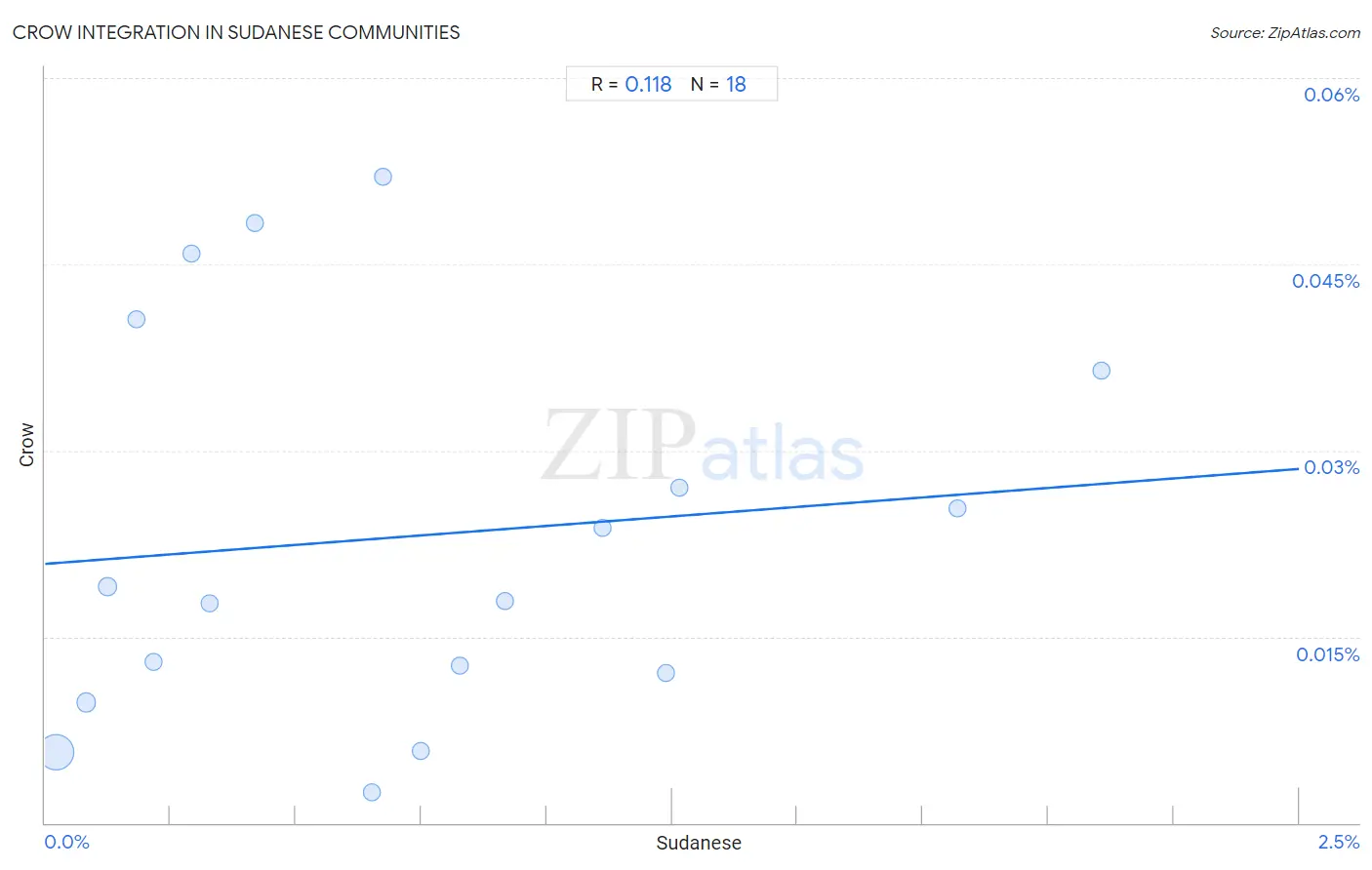
Sudanese vs Crow Income
When considering income, the most significant differences between Sudanese and Crow communities in the United States are seen in per capita income ($41,695 compared to $31,729, a difference of 31.4%), median family income ($96,783 compared to $76,605, a difference of 26.3%), and householder income ages 45 - 64 years ($93,718 compared to $74,257, a difference of 26.2%). Conversely, both communities are more comparable in terms of householder income under 25 years ($46,982 compared to $47,012, a difference of 0.060%), median female earnings ($38,215 compared to $35,266, a difference of 8.4%), and median earnings ($44,419 compared to $38,707, a difference of 14.8%).

| Income Metric | Sudanese | Crow |
| Per Capita Income | Tragic $41,695 | Tragic $31,729 |
| Median Family Income | Tragic $96,783 | Tragic $76,605 |
| Median Household Income | Tragic $78,529 | Tragic $63,681 |
| Median Earnings | Tragic $44,419 | Tragic $38,707 |
| Median Male Earnings | Tragic $51,216 | Tragic $42,434 |
| Median Female Earnings | Tragic $38,215 | Tragic $35,266 |
| Householder Age | Under 25 years | Tragic $46,982 | Tragic $47,012 |
| Householder Age | 25 - 44 years | Tragic $84,401 | Tragic $71,337 |
| Householder Age | 45 - 64 years | Tragic $93,718 | Tragic $74,257 |
| Householder Age | Over 65 years | Tragic $58,281 | Tragic $49,234 |
| Wage/Income Gap | Exceptional 24.0% | Exceptional 19.1% |
Sudanese vs Crow Poverty
When considering poverty, the most significant differences between Sudanese and Crow communities in the United States are seen in single father poverty (15.9% compared to 30.3%, a difference of 90.9%), single male poverty (13.1% compared to 23.3%, a difference of 78.2%), and married-couple family poverty (5.6% compared to 9.6%, a difference of 70.0%). Conversely, both communities are more comparable in terms of receiving food stamps (12.0% compared to 13.4%, a difference of 11.7%), single mother poverty (30.0% compared to 38.6%, a difference of 28.6%), and seniors poverty over the age of 75 (11.8% compared to 15.9%, a difference of 35.3%).
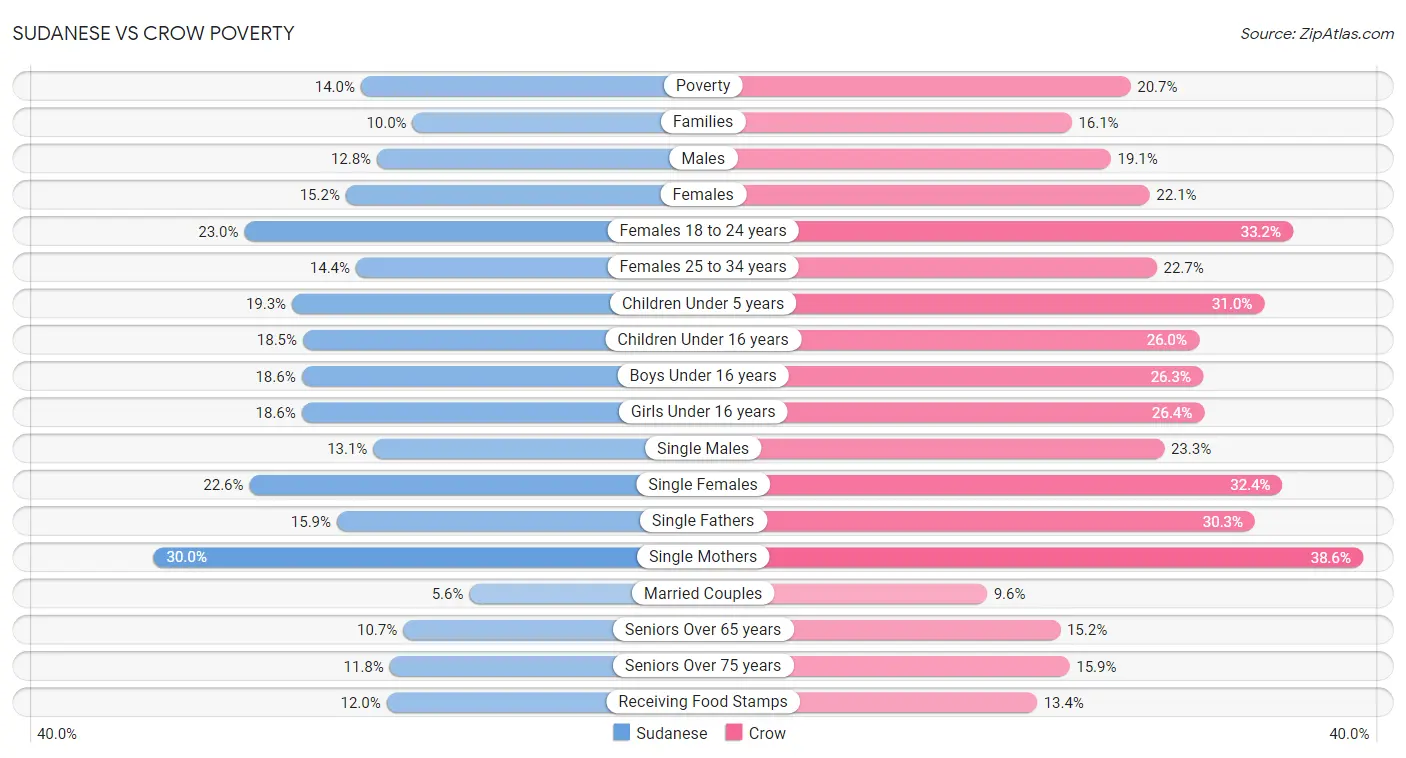
| Poverty Metric | Sudanese | Crow |
| Poverty | Tragic 14.0% | Tragic 20.7% |
| Families | Tragic 10.0% | Tragic 16.1% |
| Males | Tragic 12.8% | Tragic 19.1% |
| Females | Tragic 15.2% | Tragic 22.1% |
| Females 18 to 24 years | Tragic 23.0% | Tragic 33.2% |
| Females 25 to 34 years | Tragic 14.4% | Tragic 22.7% |
| Children Under 5 years | Tragic 19.3% | Tragic 31.0% |
| Children Under 16 years | Tragic 18.5% | Tragic 26.0% |
| Boys Under 16 years | Tragic 18.6% | Tragic 26.3% |
| Girls Under 16 years | Tragic 18.6% | Tragic 26.4% |
| Single Males | Poor 13.1% | Tragic 23.3% |
| Single Females | Tragic 22.6% | Tragic 32.4% |
| Single Fathers | Exceptional 15.9% | Tragic 30.3% |
| Single Mothers | Tragic 30.0% | Tragic 38.6% |
| Married Couples | Tragic 5.6% | Tragic 9.6% |
| Seniors Over 65 years | Good 10.7% | Tragic 15.2% |
| Seniors Over 75 years | Excellent 11.8% | Tragic 15.9% |
| Receiving Food Stamps | Fair 12.0% | Tragic 13.4% |
Sudanese vs Crow Unemployment
When considering unemployment, the most significant differences between Sudanese and Crow communities in the United States are seen in unemployment among seniors over 65 years (4.4% compared to 16.9%, a difference of 282.9%), unemployment among ages 35 to 44 years (4.1% compared to 15.7%, a difference of 279.8%), and unemployment among ages 65 to 74 years (4.6% compared to 17.4%, a difference of 278.1%). Conversely, both communities are more comparable in terms of unemployment among ages 60 to 64 years (4.3% compared to 5.0%, a difference of 13.9%), unemployment among women with children ages 6 to 17 years (7.4% compared to 9.2%, a difference of 24.7%), and unemployment among ages 55 to 59 years (4.6% compared to 5.9%, a difference of 28.1%).
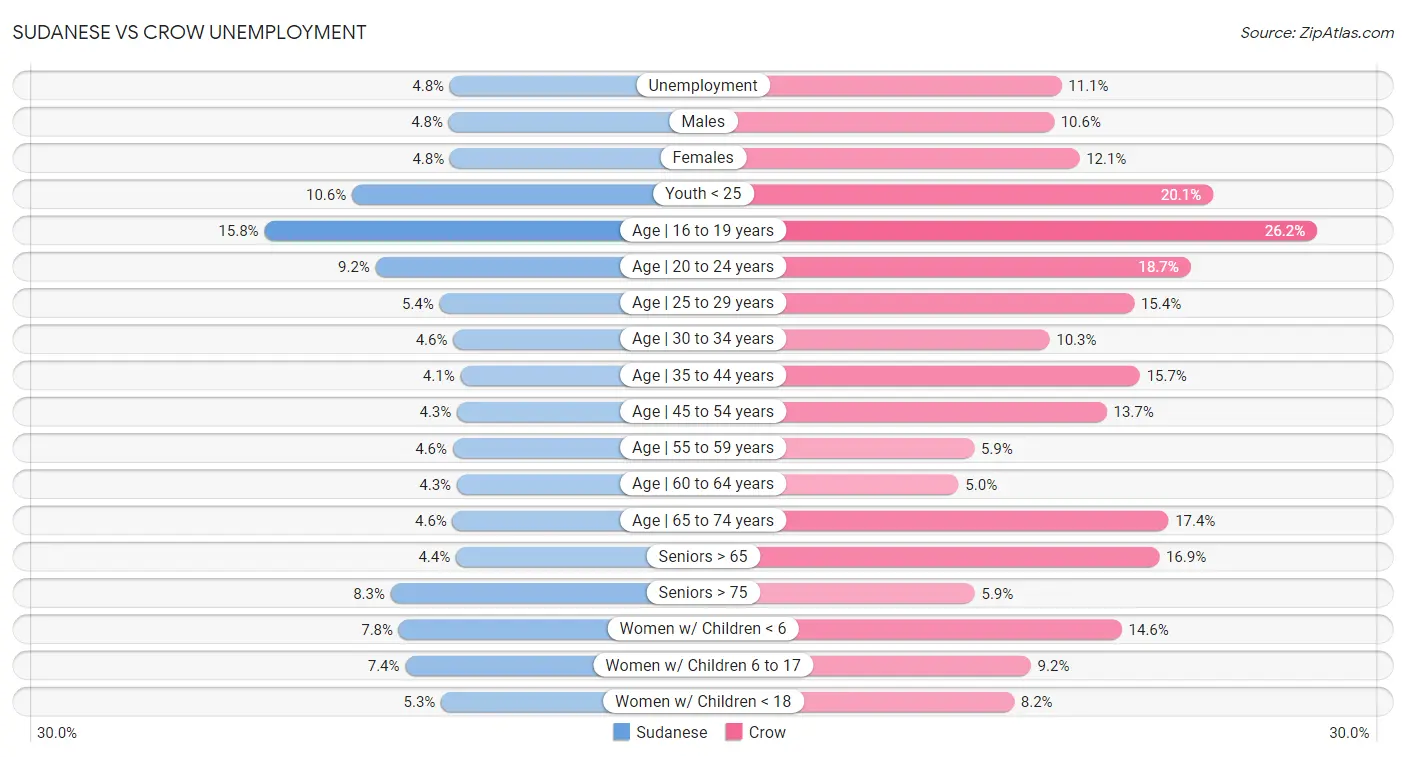
| Unemployment Metric | Sudanese | Crow |
| Unemployment | Exceptional 4.8% | Tragic 11.1% |
| Males | Exceptional 4.8% | Tragic 10.6% |
| Females | Exceptional 4.8% | Tragic 12.1% |
| Youth < 25 | Exceptional 10.6% | Tragic 20.1% |
| Age | 16 to 19 years | Exceptional 15.8% | Tragic 26.2% |
| Age | 20 to 24 years | Exceptional 9.2% | Tragic 18.7% |
| Age | 25 to 29 years | Exceptional 5.4% | Tragic 15.4% |
| Age | 30 to 34 years | Exceptional 4.6% | Tragic 10.3% |
| Age | 35 to 44 years | Exceptional 4.1% | Tragic 15.7% |
| Age | 45 to 54 years | Exceptional 4.3% | Tragic 13.7% |
| Age | 55 to 59 years | Exceptional 4.6% | Tragic 5.9% |
| Age | 60 to 64 years | Exceptional 4.3% | Tragic 5.0% |
| Age | 65 to 74 years | Exceptional 4.6% | Tragic 17.4% |
| Seniors > 65 | Exceptional 4.4% | Tragic 16.9% |
| Seniors > 75 | Exceptional 8.3% | Exceptional 5.9% |
| Women w/ Children < 6 | Fair 7.8% | Tragic 14.6% |
| Women w/ Children 6 to 17 | Exceptional 7.4% | Tragic 9.2% |
| Women w/ Children < 18 | Excellent 5.3% | Tragic 8.2% |
Sudanese vs Crow Labor Participation
When considering labor participation, the most significant differences between Sudanese and Crow communities in the United States are seen in in labor force | age 30-34 (85.2% compared to 75.9%, a difference of 12.2%), in labor force | age > 16 (68.0% compared to 60.8%, a difference of 11.9%), and in labor force | age 16-19 (42.9% compared to 38.5%, a difference of 11.3%). Conversely, both communities are more comparable in terms of in labor force | age 20-24 (78.4% compared to 76.9%, a difference of 2.0%), in labor force | age 45-54 (83.0% compared to 78.3%, a difference of 6.0%), and in labor force | age 25-29 (85.9% compared to 78.6%, a difference of 9.3%).

| Labor Participation Metric | Sudanese | Crow |
| In Labor Force | Age > 16 | Exceptional 68.0% | Tragic 60.8% |
| In Labor Force | Age 20-64 | Exceptional 80.8% | Tragic 73.3% |
| In Labor Force | Age 16-19 | Exceptional 42.9% | Exceptional 38.5% |
| In Labor Force | Age 20-24 | Exceptional 78.4% | Exceptional 76.9% |
| In Labor Force | Age 25-29 | Exceptional 85.9% | Tragic 78.6% |
| In Labor Force | Age 30-34 | Exceptional 85.2% | Tragic 75.9% |
| In Labor Force | Age 35-44 | Exceptional 85.0% | Tragic 76.5% |
| In Labor Force | Age 45-54 | Excellent 83.0% | Tragic 78.3% |
Sudanese vs Crow Family Structure
When considering family structure, the most significant differences between Sudanese and Crow communities in the United States are seen in single father households (2.4% compared to 3.5%, a difference of 45.3%), births to unmarried women (32.4% compared to 40.4%, a difference of 24.5%), and average family size (3.20 compared to 3.82, a difference of 19.5%). Conversely, both communities are more comparable in terms of family households with children (27.4% compared to 27.4%, a difference of 0.040%), married-couple households (42.1% compared to 41.4%, a difference of 1.8%), and single mother households (6.9% compared to 7.4%, a difference of 7.9%).

| Family Structure Metric | Sudanese | Crow |
| Family Households | Tragic 60.0% | Exceptional 65.3% |
| Family Households with Children | Fair 27.4% | Fair 27.4% |
| Married-couple Households | Tragic 42.1% | Tragic 41.4% |
| Average Family Size | Poor 3.20 | Exceptional 3.82 |
| Single Father Households | Poor 2.4% | Tragic 3.5% |
| Single Mother Households | Tragic 6.9% | Tragic 7.4% |
| Currently Married | Tragic 43.7% | Tragic 40.4% |
| Divorced or Separated | Tragic 12.4% | Tragic 14.1% |
| Births to Unmarried Women | Fair 32.4% | Tragic 40.4% |
Sudanese vs Crow Vehicle Availability
When considering vehicle availability, the most significant differences between Sudanese and Crow communities in the United States are seen in 4 or more vehicles in household (5.6% compared to 7.8%, a difference of 38.4%), 3 or more vehicles in household (17.8% compared to 22.5%, a difference of 25.9%), and no vehicles in household (9.8% compared to 11.0%, a difference of 12.1%). Conversely, both communities are more comparable in terms of 1 or more vehicles in household (90.3% compared to 89.3%, a difference of 1.1%), 2 or more vehicles in household (53.6% compared to 55.7%, a difference of 4.0%), and no vehicles in household (9.8% compared to 11.0%, a difference of 12.1%).

| Vehicle Availability Metric | Sudanese | Crow |
| No Vehicles Available | Excellent 9.8% | Poor 11.0% |
| 1+ Vehicles Available | Excellent 90.3% | Fair 89.3% |
| 2+ Vehicles Available | Tragic 53.6% | Good 55.7% |
| 3+ Vehicles Available | Tragic 17.8% | Exceptional 22.5% |
| 4+ Vehicles Available | Tragic 5.6% | Exceptional 7.8% |
Sudanese vs Crow Education Level
When considering education level, the most significant differences between Sudanese and Crow communities in the United States are seen in professional degree (4.6% compared to 3.2%, a difference of 47.0%), master's degree (15.3% compared to 10.6%, a difference of 43.9%), and doctorate degree (2.1% compared to 1.5%, a difference of 41.6%). Conversely, both communities are more comparable in terms of 11th grade (92.5% compared to 92.9%, a difference of 0.47%), high school diploma (89.1% compared to 88.4%, a difference of 0.78%), and 12th grade, no diploma (91.0% compared to 90.0%, a difference of 1.1%).
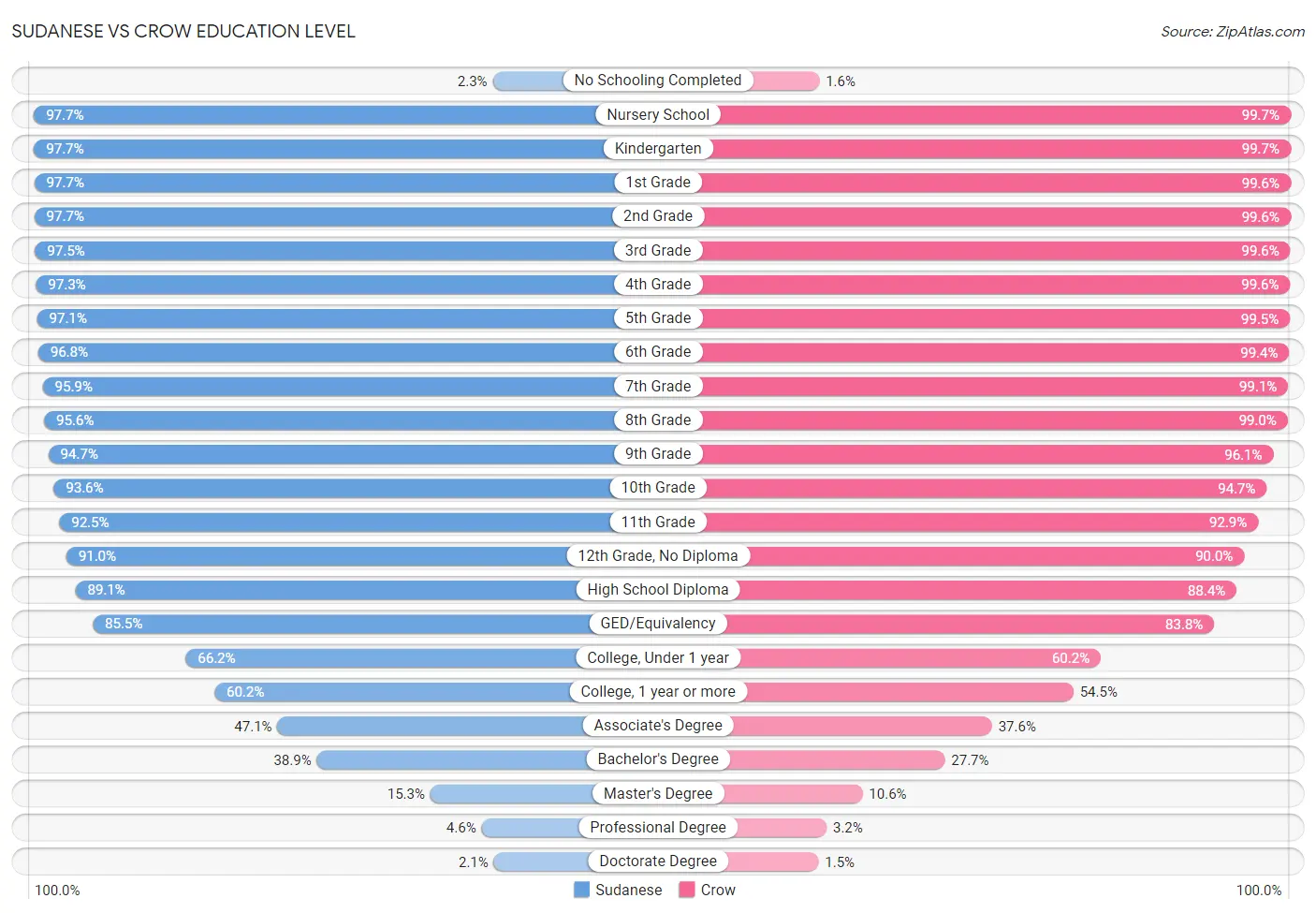
| Education Level Metric | Sudanese | Crow |
| No Schooling Completed | Tragic 2.3% | Exceptional 1.6% |
| Nursery School | Tragic 97.7% | Exceptional 99.7% |
| Kindergarten | Tragic 97.7% | Exceptional 99.7% |
| 1st Grade | Tragic 97.7% | Exceptional 99.6% |
| 2nd Grade | Tragic 97.7% | Exceptional 99.6% |
| 3rd Grade | Tragic 97.5% | Exceptional 99.6% |
| 4th Grade | Tragic 97.3% | Exceptional 99.6% |
| 5th Grade | Tragic 97.1% | Exceptional 99.5% |
| 6th Grade | Poor 96.8% | Exceptional 99.4% |
| 7th Grade | Fair 95.9% | Exceptional 99.1% |
| 8th Grade | Fair 95.6% | Exceptional 99.0% |
| 9th Grade | Fair 94.7% | Exceptional 96.1% |
| 10th Grade | Fair 93.6% | Exceptional 94.7% |
| 11th Grade | Average 92.5% | Excellent 92.9% |
| 12th Grade, No Diploma | Fair 91.0% | Tragic 90.0% |
| High School Diploma | Average 89.1% | Poor 88.4% |
| GED/Equivalency | Fair 85.5% | Tragic 83.8% |
| College, Under 1 year | Good 66.2% | Tragic 60.2% |
| College, 1 year or more | Good 60.2% | Tragic 54.5% |
| Associate's Degree | Good 47.1% | Tragic 37.6% |
| Bachelor's Degree | Good 38.9% | Tragic 27.7% |
| Master's Degree | Good 15.3% | Tragic 10.6% |
| Professional Degree | Excellent 4.6% | Tragic 3.2% |
| Doctorate Degree | Exceptional 2.1% | Tragic 1.5% |
Sudanese vs Crow Disability
When considering disability, the most significant differences between Sudanese and Crow communities in the United States are seen in hearing disability (2.9% compared to 4.2%, a difference of 42.2%), disability age 35 to 64 (11.9% compared to 14.6%, a difference of 22.6%), and ambulatory disability (5.7% compared to 6.9%, a difference of 21.0%). Conversely, both communities are more comparable in terms of disability age over 75 (47.5% compared to 49.6%, a difference of 4.3%), female disability (12.0% compared to 12.7%, a difference of 5.2%), and disability age 5 to 17 (5.8% compared to 5.4%, a difference of 8.3%).
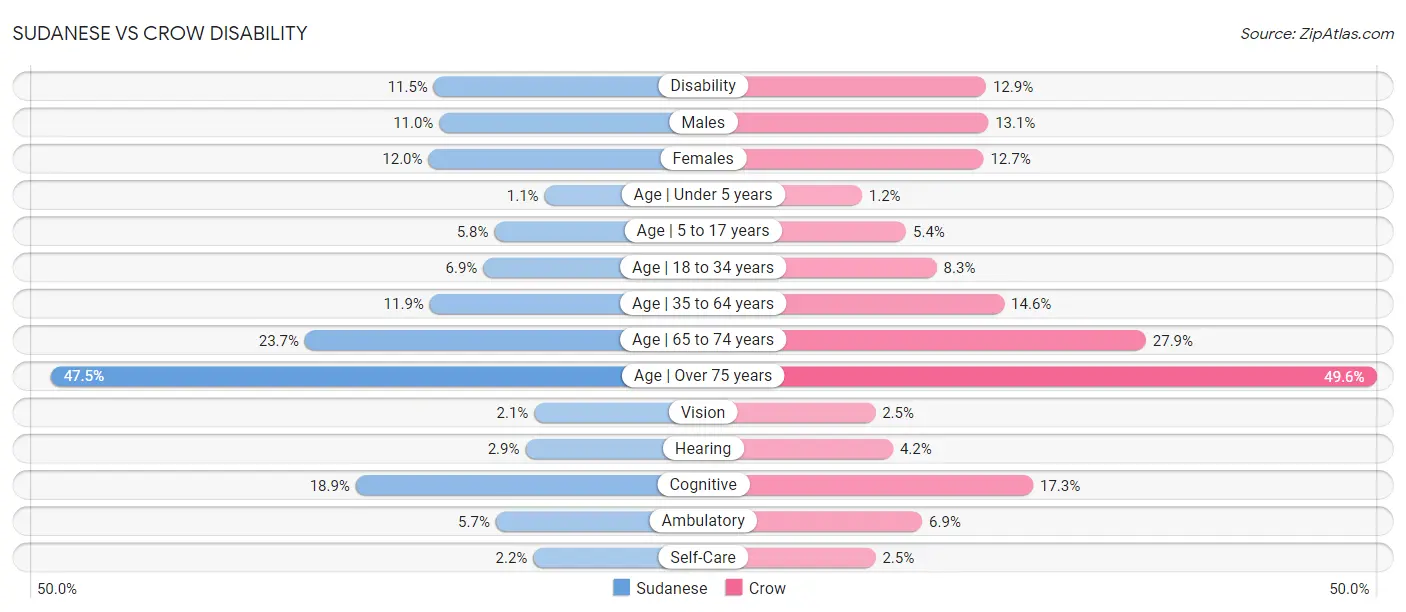
| Disability Metric | Sudanese | Crow |
| Disability | Good 11.5% | Tragic 12.9% |
| Males | Good 11.0% | Tragic 13.1% |
| Females | Good 12.0% | Tragic 12.7% |
| Age | Under 5 years | Exceptional 1.1% | Average 1.2% |
| Age | 5 to 17 years | Tragic 5.8% | Exceptional 5.4% |
| Age | 18 to 34 years | Tragic 6.9% | Tragic 8.3% |
| Age | 35 to 64 years | Tragic 11.9% | Tragic 14.6% |
| Age | 65 to 74 years | Fair 23.7% | Tragic 27.9% |
| Age | Over 75 years | Fair 47.5% | Tragic 49.6% |
| Vision | Excellent 2.1% | Tragic 2.5% |
| Hearing | Good 2.9% | Tragic 4.2% |
| Cognitive | Tragic 18.9% | Fair 17.3% |
| Ambulatory | Exceptional 5.7% | Tragic 6.9% |
| Self-Care | Exceptional 2.2% | Poor 2.5% |